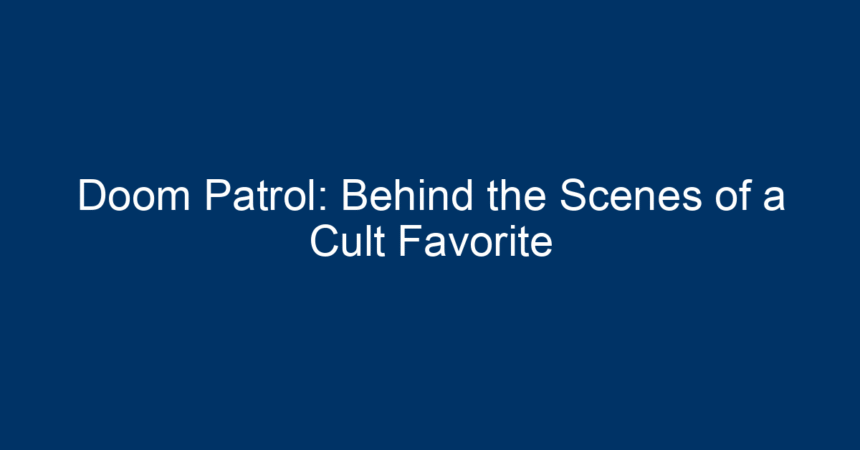Introduction
In the ever-expanding universe of superhero narratives, "Doom Patrol" stands out as a unique gem. Launched initially as a comic book series in the 1960s, it has since transformed into a beloved television series on HBO Max that has garnered a dedicated fan base. Combining elements of dark humor, existential themes, and vibrant characters, "Doom Patrol" invites viewers into a surreal and emotionally engaging world. This article delves behind the scenes of "Doom Patrol," exploring its creation, themes, characters, and the factors contributing to its cult status.
The Origins of Doom Patrol
"Doom Patrol" first appeared in the DC Comics world in 1963, introduced by writer Arnold Drake and artist Bob Brown. This original incarnation was a diverse team of misfits, setting the stage for what would become a recurring theme in superhero lore: the outsider. Over the decades, various iterations of the Doom Patrol have emerged, each reinvention reflecting the cultural changes and evolving comic book landscape.
From Comics to Screen
The transition of "Doom Patrol" from comic book pages to television screens presents a fascinating story. The show, which premiered in February 2019, was developed by Jeremy Carver, known for his innovative storytelling. Carver’s approach to the series honors the source material while introducing new viewers to the eccentricities of the characters. This adaptation not only provides thrilling entertainment but also explores deeper themes of identity, trauma, and redemption.
Character Development
One key reason for the show’s success is its rich character development. Each member of the Doom Patrol embodies unique psychological issues that resonate with audiences.
The Misfits and Their Stories
-
Robotman (Cliff Steele): Portrayed by Brendan Fraser, Cliff’s narrative is a poignant exploration of loss and regret, accentuated by his inability to connect emotionally due to his robotic body.
-
Negative Man (Larry Trainor): Played by Matt Bomer, Larry’s struggle with his dual identity and the physical scars of his past creates a deeply relatable character.
-
Elasti-Woman (Rita Farr): With her shapeshifting abilities, Rita’s journey through self-acceptance raises questions about body image and self-worth, tapping into a universal struggle.
-
Crazy Jane (Diane Guerrero): This character brings a vibrant complexity, showcasing multiple personalities, each with its own power. Her story arc emphasizes mental health issues, presenting them with sensitivity and depth.
- The Chief (Niles Caulder): Played by Timothy Dalton, The Chief acts as both a mentor and antagonist, embodying moral ambiguity and the question of ethical responsibility in caregiving.
Dynamic Interactions
The relationships within the ensemble cast contribute significantly to the show’s depth. The dysfunctional dynamic among the characters showcases their individual traumas, often leading to comedic yet poignant moments. This blend of humor and gravity is a hallmark of the series, making it resonate with fans who appreciate storytelling that challenges typical superhero tropes.
Themes of Doom Patrol
"Doom Patrol" isn’t just about superheroes; it’s a narrative steeped in deeper themes. Each episode often tackles complex subjects which are rarely addressed in traditional superhero media.
Identity and Self-Acceptance
At its core, "Doom Patrol" explores the idea of identity. Each member grapples with personal demons and seeks acceptance in a world that often overlooks them. The show prompts viewers to reflect on their own identities and the masks they wear in society.
Mental Health Awareness
Perhaps one of the most significant contributions of "Doom Patrol" is its frank discussion of mental health issues. By portraying characters with mental health struggles, the series opens dialogue about these topics, normalizing conversations that are often stigmatized. The depiction of therapy, self-discovery, and support further enriches the narrative, providing valuable insights into the importance of mental well-being.
Redemption and Acceptance
Another recurring theme in "Doom Patrol" is the quest for redemption. The characters’ journeys often involve seeking forgiveness—both from themselves and others—as they confront their pasts. This exploration of personal growth and redemption elevates the show, allowing for both humor and heartfelt moments.
Visual Style and Production
The visual identity of "Doom Patrol" is as unique as its storytelling. The series boasts a bold and eclectic artistic style that mirrors its quirky tone.
Cinematic Techniques
The production team employs a mix of practical effects, elaborate costumes, and imaginative set designs to create a visually stunning experience. The show’s aesthetic often blends surreal elements with gritty realism, drawing viewers into its fantastical yet relatable world.
Unique Directorial Choices
Various directors contribute to the series, allowing for a diversity of styles and perspectives. This variety enhances character development and theme exploration, ensuring each episode feels fresh while remaining true to the overall narrative arc.
Cult Following: What Makes Doom Patrol Special
"Doom Patrol" has developed a passionate fanbase, often termed a "cult following." This designation stems from several factors:
Subversion of Superhero Tropes
Unlike traditional superhero narratives that often adhere to a clear-cut moral code, "Doom Patrol" subverts expectations. This unpredictability keeps audiences engaged, as they never quite know where the story is headed.
Strong Character Connections
Fans resonate deeply with the characters’ flaws and strengths. The relatability of the cast fosters a strong emotional connection, allowing viewers to see themselves within the narratives.
Engaging Story Arcs
With cliffhangers, emotional depth, and character growth, each season of "Doom Patrol" offers compelling story arcs. The writers skillfully balance humor and drama, making the series not just entertaining but also introspective.
Conclusion: The Legacy of Doom Patrol
"Doom Patrol" has proven to be more than just another superhero show. Its exploration of identity, mental health, and redemption, combined with its unique visual style and memorable characters, has cemented its place as a cult favorite.
Actionable Insights for Fans
-
Explore the Comics: Delve deeper into the rich history of the Doom Patrol in the comic books to uncover more about its characters and plots.
-
Join the Community: Engage with fellow fans through online forums or social media groups. Sharing theories and interpretations can enhance the viewing experience.
-
Support Mental Health Initiatives: Inspired by the show’s themes, consider participating in mental health awareness campaigns or donating to relevant organizations.
-
Stay Updated: Follow news related to upcoming seasons, spin-offs, or related DC projects to remain in the loop about this dynamic universe.
- Rewatch Key Episodes: Revisiting key episodes can highlight the intricate storytelling and character development that makes "Doom Patrol" so special.
In summary, “Doom Patrol” is not just another entry in the superhero genre; it’s a multifaceted exploration of what it means to be different, and its place in popular culture continues to grow.




